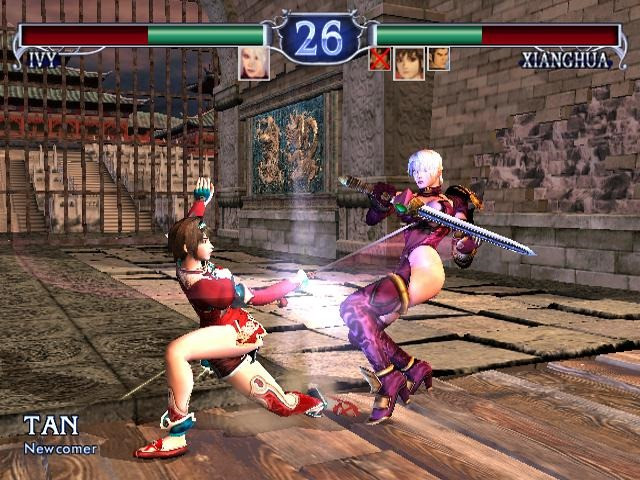Game: Soul Calibur II
Console: Xbox
Developer: Namco
Release Date: 27th August 2003
Appearing on 3 of the 4 sixth generation games consoles, Soul Calibur II had an exclusive character for each version. Spawn (a comic book character) appeared in the Xbox version, Link (Legend of Zelda) appeared in the Gamecube version, and Heihachi Mishima (from Tekken) appeared in the PS2 version. Featuring a total of 23 characters, there's a good amount of choice and variation between characters. As a fighting game, Soul Calibur II is a little different from other titles, with more focus on weapon combat and blocks than physical attacks.
There are two main modes, as well as a large amount of supplementary modes which are unlockable through Weapon Master Mode. In this mode, you take control of a character of your choice and journey through different lands in order to get the Soul Edge, a legendary sword. With 10 chapters, 4 subchapters, and 2 extra chapters, this mode is pretty long (each chapter contains 4-6 stages where you must fight). Arcade Mode is as you might expect, the regular mode in a tournament fighting game, working your way through 8 opponents toward an ending.
The gameplay is smooth and balanced, with 8 way movement in three dimensions, a nice block and counter system. The main attack options are vertical strikes, horizontal strikes and kicks all of which have different ranges and are useful in different situations and you're also able to throw with a combination of two buttons. The player is able to block using the a button, but to get into a favourable position after an enemy attack it's best to use guard impact, which is pressing A and the d-pad towards the enemy at the correct time to counter the enemy and throw them off balance.
This simple, but effective set of controls serves to give the game movesets which can be used by both beginners and seasoned players to be competitive. Alongside the basic controls, there are combos and special moves which can be learned as a player advances with a certain character but the most effective weapon in the game tends to be timing.
I mentioned Weapon Master Mode in a little detail earlier in the review, but I think it's only fair to explain it a little more. You begin chapter one in Regulus at a training centre and after learning the basic moves, progress to the first couple of fights which are easy to clear. As the chapters wear on, there are different objectives for some fights, such as invisible enemies, timed fights and having to use guard impact to damage opponents. This mode is very helpful for players who wish to become better at the game, since there's a lot of different tactics which need to be used in order to progress.
Although it can get a little too long after a while, it's an interesting main mode for a fighting game as there's a lot of variation and even more story than games like Tekken or Rival Schools. The only real downside is that I felt less inclined to complete arcade mode with each character after playing Weapon Master Mode. Most, if not all of the unlockable characters, weapons and stages are accessed via this mode also.
The other modes are reminiscent of Tekken, with Team Battle, Time Attack and Survival modes available, both with the characters default weapons, and ones earned in Weapon Master Mode. Additionally there's Gallery and Theatre modes where players can look through artwork for the game and watch cutscenes that have been unlocked.
The character designs overall are fairly varied, although at times it can be difficult to differentiate between moody sword wielding fighters. The stages in the game can also get a little samey, with dungeon stages in Weapon Master Mode being basically the same all the way though. There's also a lot of stages that fighters can fall from, resulting in a win for the other player. This makes for a nice balance in a way, but can also get easily abused in game.
Graphically, the game looks great on Xbox with a large amount of detail put into both the characters and their clothes, as well as the environments and areas where the fighting takes place. With the ability to play in HD (720p), its the best looking version from the 6th generation. Musically the game can be a little bland and disappointing in places, with a lot of the soundtrack hardly even registering whilst the game is being played.
Overall Soul Calibur has all the elements of a good fighting game; Simple controls which can be used to a skilled players advantage, an impressive guarding system, challenging gameplay with lots of modes, characters and stages to choose from. Weapon Master mode makes a nice addition also with extra playability and features to unlock for the player that make the game more appealing than some of its counterparts. While it does suffer from some repetitivity in stages and concept later on in Weapons Master mode, the gameplay and general concept of weapon based fighting is impressively pulled off.
I'd reccomend this as a place to start, even if you don't enjoy fighting games because its easy to pick up and play, has a lot of replay value and there's a lot more to it than "just tournament fighting". I'm hoping that soon I'll pick up both of the other versions of this game for Gamecube and PS2, as well as the original for Dreamcast.
Rating: 87/100
Grade: B






No comments:
Post a Comment